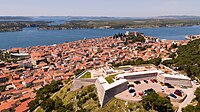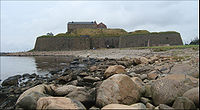List of surviving castles in Faneria: Difference between revisions
WIP Tag: 2017 source edit |
mNo edit summary Tag: 2017 source edit |
||
| Line 1: | Line 1: | ||
{{WIP}} | {{WIP}} | ||
Fortifications of various types have been extremely common in what is now southern [[Faneria]] since the early Second Century AD, and were often constructed over historic wooden mottes or other naturally-defensible features to control river crossings, provide a vantage point over surrounding countryside, and impede passage along major roadways. Due to continuous human habitation leading to warfare, reuse of materials, and the leveling or replacement of many of these sites, extremely little remains of most original constructions. Between 1906 and 1938, castles and fortifications were unprotected public property and no preservation efforts were made by the Republican government, allowing a number of estates preserved by Royal institutions to be further damaged or entirely dismantled. Twenty-three remaining castles and major fortresses (collectively referred to as ''Dunn'' in [[Fhasen]]) protected by local governments or private purchase were designated as 'Sites Important to the Understanding of National History and Culture' by the Fhainnin government throughout the late Twentieth Century, and are currently preserved and protected by the [[Office of Culture (Faneria)#Bureau of National Parks|Bureau of National Parks]]. | Fortifications of various types have been extremely common in what is now southern [[Faneria]] since the early Second Century AD, and were often constructed over historic wooden mottes or other naturally-defensible features to control river crossings, provide a vantage point over surrounding countryside, and impede passage along major roadways. Due to continuous human habitation leading to warfare, reuse of materials, and the leveling or replacement of many of these sites, extremely little remains of most original constructions. Between 1906 and 1938, castles and fortifications were unprotected public property and no preservation efforts were made by the Republican government, allowing a number of estates preserved by Royal institutions to be further damaged or entirely dismantled. Twenty-three remaining castles and major fortresses (collectively referred to as ''Dunn'' in [[Fhasen]]) protected by local governments or private purchase were designated as 'Sites Important to the Understanding of National History and Culture' by the Fhainnin government throughout the late Twentieth Century, and are currently preserved and protected by the [[Office of Culture (Faneria)#Bureau of National Parks|Bureau of National Parks]]. Of these, only a few are open to the public. | ||
[[File:Krakovec Castle 1.jpg|thumb|200x200px]] | |||
[[File:Image from page 82 of "History of the U. S. S. Leviathan, cruiser and transport forces, United States Atlantic fleet" (1919).jpg|thumb|200x200px]] | |||
[[File:Barone izgradnja-43.jpg|thumb|200x200px]] | |||
[[File:Tvrdava.sv.mihovil.sibenik.JPG|thumb|200x200px]] | |||
[[File:Neuf-Brisach 007 850.jpg|thumb|200x200px]] | |||
[[File:Fort de Bregille.JPG|thumb|200x200px]] | |||
[[File:Varbergs fästning från söder.jpg|thumb|200x200px]] | |||
[[File:Borgholms slottsruin från luften.jpg|thumb|200x200px]] | |||
[[File:Fortezza del Priamar dalle alture Savonesi.JPG|thumb|200x200px]] | |||
[[File:Alois von Saar - Prager Burg – Hradschin - 7905 - Kunsthistorisches Museum.jpg|thumb|200x200px]] | |||
[[File:Praha widok z Wyszehradu 4.jpg|thumb|200x200px]] | |||
[[File:Bezdez.jpg|thumb|200x200px]] | |||
Revision as of 02:36, 12 October 2023
This article is a work-in-progress because it is incomplete and pending further input from an author. Note: The contents of this article are not considered canonical and may be inaccurate. Please comment on this article's talk page to share your input, comments and questions. |
Fortifications of various types have been extremely common in what is now southern Faneria since the early Second Century AD, and were often constructed over historic wooden mottes or other naturally-defensible features to control river crossings, provide a vantage point over surrounding countryside, and impede passage along major roadways. Due to continuous human habitation leading to warfare, reuse of materials, and the leveling or replacement of many of these sites, extremely little remains of most original constructions. Between 1906 and 1938, castles and fortifications were unprotected public property and no preservation efforts were made by the Republican government, allowing a number of estates preserved by Royal institutions to be further damaged or entirely dismantled. Twenty-three remaining castles and major fortresses (collectively referred to as Dunn in Fhasen) protected by local governments or private purchase were designated as 'Sites Important to the Understanding of National History and Culture' by the Fhainnin government throughout the late Twentieth Century, and are currently preserved and protected by the Bureau of National Parks. Of these, only a few are open to the public.











